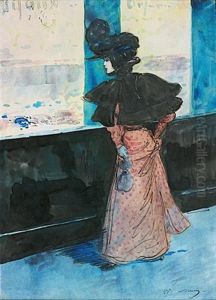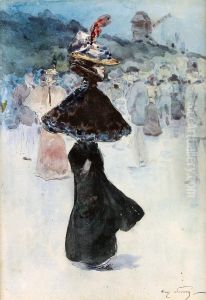Francois Clement Somm Paintings
François Clément Somm, born in 1844 and passing in 1907, was a French illustrator, engraver, and painter, whose work is emblematic of the Belle Époque period, a time characterized by cultural flourishing and innovation in European art and literature. His career was notably aligned with the aesthetic and thematic preoccupations of this era, reflecting its fascination with modernity as well as a nostalgic appreciation for historical subjects.
Somm's oeuvre is diverse, encompassing book illustrations, magazine covers, and standalone artworks, which often featured scenes of historical significance, portraits, and genre scenes that captured everyday life with a keen eye for detail and a profound sense of empathy. His illustrations for books and periodicals were particularly celebrated for their ability to enhance the narrative, adding layers of visual meaning that complemented the text. This work, produced through engraving and later through the emerging technology of lithography, allowed for widespread dissemination of his images, contributing significantly to his popularity during his lifetime.
Educated in Paris, Somm was part of a vibrant artistic community, engaging with the various movements that contributed to the rich tapestry of 19th-century French art. Though not as widely recognized today as some of his contemporaries, his contribution to the art of illustration and his ability to capture the essence of his time remain noteworthy. His artistic legacy is preserved in the collections of French museums and in the illustrated books and periodicals of the late 19th and early 20th centuries.
Throughout his career, Somm exhibited his work at the Paris Salon, an essential venue for artists seeking recognition and patronage during this period. His style evolved over the years from a strict academic adherence to a more fluid, expressive approach that mirrored the broader shifts in European art as it moved towards Modernism. François Clément Somm's death in 1907 marked the end of a career that had adeptly encapsulated the spirit of an age, leaving behind a body of work that continues to offer insights into the Belle Époque's complex cultural landscape.


